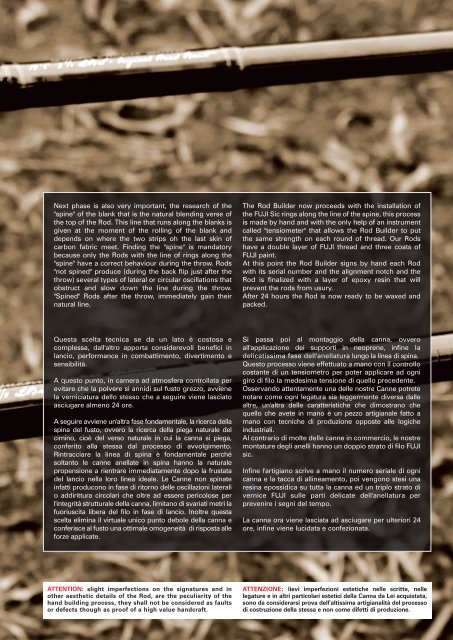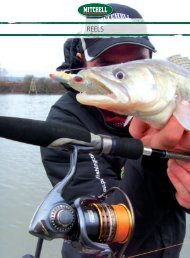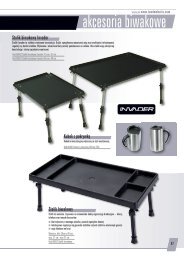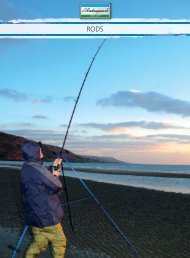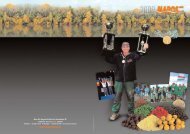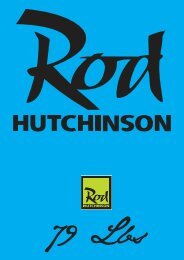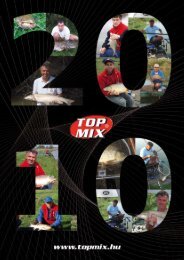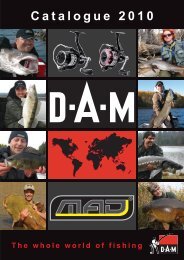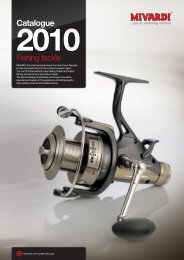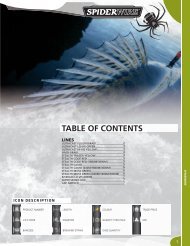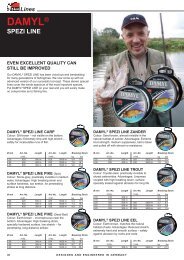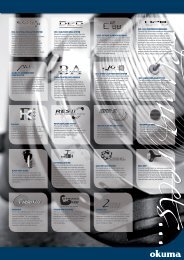Rod Hutchinson - Csali butik
Rod Hutchinson - Csali butik
Rod Hutchinson - Csali butik
You also want an ePaper? Increase the reach of your titles
YUMPU automatically turns print PDFs into web optimized ePapers that Google loves.
Next phase is also very important, the research of the<br />
"spine" of the blank that is the natural blending verse of<br />
the top of the <strong>Rod</strong>. This line that runs along the blanks is<br />
given at the moment of the rolling of the blank and<br />
depends on where the two strips oh the last skin of<br />
carbon fabric meet. Finding the "spine" is mandatory<br />
because only the <strong>Rod</strong>s with the line of rings along the<br />
"spine" have a correct behaviour during the throw. <strong>Rod</strong>s<br />
"not spined" produce (during the back flip just after the<br />
throw) several types of lateral or circular oscillations that<br />
obstruct and slow down the line during the throw.<br />
"Spined" <strong>Rod</strong>s after the throw, immediately gain their<br />
natural line.<br />
The <strong>Rod</strong> Builder now proceeds with the installation of<br />
the FUJI Sic rings along the line of the spine, this process<br />
is made by hand and with the only help of an instrument<br />
called "tensiometer" that allows the <strong>Rod</strong> Builder to put<br />
the same strength on each round of thread. Our <strong>Rod</strong>s<br />
have a double layer of FUJI thread and three coats of<br />
FUJI paint.<br />
At this point the <strong>Rod</strong> Builder signs by hand each <strong>Rod</strong><br />
with its serial number and the alignment notch and the<br />
<strong>Rod</strong> is finalized with a layer of epoxy resin that will<br />
prevent the rods from usury.<br />
After 24 hours the <strong>Rod</strong> is now ready to be waxed and<br />
packed.<br />
Questa scelta tecnica se da un lato è costosa e<br />
complessa, dall'altro apporta considerevoli benefici in<br />
lancio, performance in combattimento, divertimento e<br />
sensibilità.<br />
A questo punto, in camera ad atmosfera controllata per<br />
evitare che la polvere si annidi sul fusto grezzo, avviene<br />
la verniciatura dello stesso che a seguire viene lasciato<br />
asciugare almeno 24 ore.<br />
A seguire avviene un'altra fase fondamentale, la ricerca della<br />
spina del fusto, ovvero la ricerca della piega naturale del<br />
cimino, cioè del verso naturale in cui la canna si piega,<br />
conferito alla stessa dal processo di avvolgimento.<br />
Rintracciare la linea di spina è fondamentale perché<br />
soltanto le canne anellate in spina hanno la naturale<br />
propensione a rientrare immediatamente dopo la frustata<br />
del lancio nella loro linea ideale. Le Canne non spinate<br />
infatti producono in fase di ritorno delle oscillazioni laterali<br />
o addirittura circolari che oltre ad essere pericolose per<br />
l'integrità strutturale della canna, limitano di svariati metri la<br />
fuoriuscita libera del filo in fase di lancio. Inoltre questa<br />
scelta elimina il virtuale unico punto debole della canna e<br />
conferisce al fusto una ottimale omogeneità di risposta alle<br />
forze applicate.<br />
Si passa poi al montaggio della canna, ovvero<br />
all'applicazione dei supporti in neoprene, infine la<br />
delicatissima fase dell'anellatura lungo la linea di spina.<br />
Questo processo viene effettuato a mano con il controllo<br />
costante di un tensiometro per poter applicare ad ogni<br />
giro di filo la medesima tensione di quello precedente.<br />
Osservando attentamente una delle nostre Canne potrete<br />
notare come ogni legatura sia leggermente diversa dalle<br />
altre, un'altra delle caratteristiche che dimostrano che<br />
quello che avete in mano è un pezzo artigianale fatto a<br />
mano con tecniche di produzione opposte alle logiche<br />
industriali.<br />
Al contrario di molte delle canne in commercio, le nostre<br />
montature degli anelli hanno un doppio strato di filo FUJI<br />
sic.<br />
Infine l'artigiano scrive a mano il numero seriale di ogni<br />
canna e la tacca di allineamento, poi vengono stesi una<br />
resina epossidica su tutta la canna ed un triplo strato di<br />
vernice FUJI sulle parti delicate dell'anellatura per<br />
prevenire i segni del tempo.<br />
La canna ora viene lasciata ad asciugare per ulteriori 24<br />
ore, infine viene lucidata e confezionata.<br />
ATTENTION: slight imperfections on the signatures and in<br />
other aesthetic details of the <strong>Rod</strong>, are the peculiarity of the<br />
hand building process, they shall not be considered as faults<br />
or defects though as proof of a high value handcraft.<br />
ATTENZIONE: lievi imperfezioni estetiche nelle scritte, nelle<br />
legature e in altri particolari estetici della Canna da Lei acquistata,<br />
sono da considerarsi prova dell’altissima artigianalità del processo<br />
di costruzione della stessa e non come difetti di produzione.


